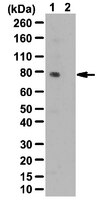07-1519 Sigma-AldrichAnti-phospho Grb10 (Ser503) Antibody
This Anti-phospho Grb10 (Ser503) Antibody is validated for use in Peptide Inhibition Assay, Western Blotting for the detection of phospho Grb10 (Ser503).
More>> This Anti-phospho Grb10 (Ser503) Antibody is validated for use in Peptide Inhibition Assay, Western Blotting for the detection of phospho Grb10 (Ser503). Less<<Recommended Products
개요
| Replacement Information |
|---|
주요 사양표
| Species Reactivity | Key Applications | Host | Format | Antibody Type |
|---|---|---|---|---|
| M | PIA, WB | Rb | Affinity Purified | Polyclonal Antibody |
| References |
|---|
| Product Information | |
|---|---|
| Format | Affinity Purified |
| Control |
|
| Presentation | Purified rabbit polyclonal in buffer containing 0.1 M Tris-Glycine (pH 7.4), 150 mM NaCl with 0.05% sodium azide. |
| Quality Level | MQ100 |
| Physicochemical Information |
|---|
| Dimensions |
|---|
| Materials Information |
|---|
| Toxicological Information |
|---|
| Safety Information according to GHS |
|---|
| Safety Information |
|---|
| Storage and Shipping Information | |
|---|---|
| Storage Conditions | Stable for 1 year at 2-8°C from date of receipt. |
| Packaging Information | |
|---|---|
| Material Size | 100 µg |
| Transport Information |
|---|
| Supplemental Information |
|---|
| Specifications |
|---|
| Global Trade Item Number | |
|---|---|
| 카탈로그 번호 | GTIN |
| 07-1519 | 04053252596018 |
Documentation
Anti-phospho Grb10 (Ser503) Antibody MSDS
| 타이틀 |
|---|
Anti-phospho Grb10 (Ser503) Antibody Certificates of Analysis
| Title | Lot Number |
|---|---|
| Anti-phospho-Grb10 (Ser503) - 2394056 | 2394056 |
| Anti-phospho-Grb10 (Ser503) - 3470733 | 3470733 |
| Anti-phospho-Grb10 (Ser503) - Q1998582 | Q1998582 |
| Anti-phospho-Grb10 (Ser503) -2490726 | 2490726 |
Brochure
| Title |
|---|
| New Products: Volume 3, 2012 |















